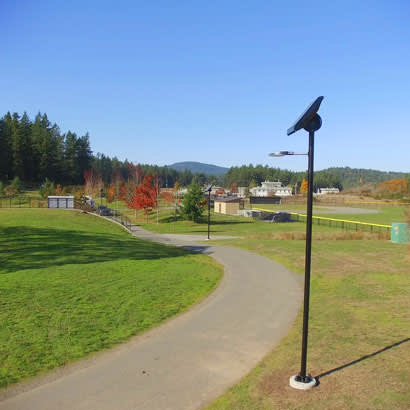
Approximately a half mile of pathway at Layritz Park in the District of Saanich in British Columbia, Canada, required multiuse pathway lighting. This heavily used portion of the park’s trail is a primary link from the parking lot to the athletic fields and, ultimately, to the nearby Vancouver Island Tech Park.
The District of Saanich, the largest municipality on Vancouver Island, includes urban areas, many rural areas and farms, and is home to the Dominion Astrophysical Observatory, which until the 1960s, was one of the main astrophysical research centers in the world. Saanich strives to provide its more than 114,000 residents with a harmonious balance with the environment, and, to that end, is committed to becoming a 100 percent renewable energy community and to reducing greenhouse gas emissions by 80 percent below 2007 levels by 2050. In keeping with its renewable energy goal, as well as its desire to cause minimal impact on the environment, the city researched the available solar lighting options and chose Urban Solar’s RMS Series lighting systems, which perform well in the challenging Pacific Northwest climate.
“This site at Layritz Park provided some challenges as it’s home to many trees, and shade lessens the ability for the panels to capture enough sun,” says Eben Lindsey, Urban Solar business development manager. “However, we were able to work closely with Saanich and found a solution by properly positioning the solar lighting systems.” The company’s stand-alone systems also meant that the lighting could be installed without the need to dig any trenches, limiting the environmental impact of installation.
“Solar proved to be more cost-efficient, in part because it is much simpler to install than conventional lighting systems,” says Becky Goodall, park planner and designer in the Parks Division of Saanich’s Parks and Recreation Department. Also, because of the park’s proximity to the Dominion Astrophysical Observatory, lower illumination fixtures were needed for the project. “Illumination levels had to comply with the Municipal Outdoor Lighting Standards for the Control of Light Pollution, including those that apply within 5 kilometers of the Dominion Astrophysical Observatory,” Goodall explains.
“We’ve received positive feedback on the lights,” Goodall continues. “They give a soft, warm light, which does the job, without being glaring.”
According to Gary Darrah, Saanich’s manager of park planning, design and development, it took about a week to install the 14 solar-powered lights, at a total cost of $52,000. The Saanich Parks and Public Works department installed the cement bases for the poles and the fixtures, while Urban Solar provided expert guidance on the overall installation and final adjustments of the solar lights, which is key. It’s a system that requires very little maintenance with a free source of energy. However, it is necessary to change the batteries every four to five years, so it’s important to have a battery replacement/system maintenance plan in place to ensure the lighting systems continue to provide reliable and safe lighting.
As the cost of electricity continues to climb, solar lighting is becoming an attractive alternative. In the past decade, improvements in LED technology, as well as in panel efficiency, have allowed solar lighting to be more effective. The lack of trenching to install wiring also makes solar lighting a good alternative in environmentally sensitive areas.
Some Interesting Solar Power Facts:
- Sunlight takes a little more than 8 minutes to reach Earth and a few seconds longer to make contact with your solar panels.
- In the United States, solar panels need to face south to capture optimal sunlight.
- Currently, the sun burns hydrogen. One day when all the hydrogen is gone [this is millions of years away], it will switch to helium — but that doesn’t matter for solar panels. They’ll continue to use the sun’s rays to create electricity.
- According to data from 2016, California generates the most solar power in America, followed by North Carolina, Arizona, Nevada, New Jersey and Utah.
- Burlington, Vermont, was the first city in America to achieve 100 percent sustainable energy production for its people.
Source: The Solar Power Authority
Sonia Myrick is the Executive Editor for Parks and Recreation magazine.

